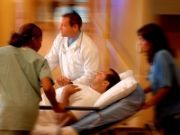Article
Study Reveals Clues That May Indicate Increased Risk for Biphasic Reaction in Patients Who Experience Anaphylaxis
Author(s):
New research may help doctors predict when patients who have suffered one attack of anaphylaxis will undergo a second attack without any additional exposure to the original trigger.

New research may help doctors predict when patients who have suffered one attack of anaphylaxis will undergo a second attack without any additional exposure to the original trigger.
The study, which was recently published in The Journal of Allergy and Clinical Immunology: In Practice, sheds new light on the little understood phenomenon, which is known as a biphasic reaction.
Mayo Clinic researchers pulled records for 541 patients whose anaphylaxis brought them to the emergency department (ED) of St. Mary’s Hospital between April 2008 and January 2013.
Then, in a effort to see which patients were most likely to have a biphasic reaction, they analyzed the patients’ personal characteristics, past medical histories, suspected triggers, symptoms during anaphylaxis, and the treatment they received during their time at the hospital.
“Based on our study,” the authors wrote, “patients with a history of prior anaphylaxis and those presenting with symptoms of wheezing or diarrhea may be at increased risk for a biphasic reaction.”
What’s more, the authors warned, EDs must keep patients long after their symptoms subside, particularly when those patients may be at heightened risk of suffering another attack.
“Many biphasic reactions manifested beyond 6 hours after initial symptoms resolved,” they wrote, noting that such events could take place a full 3 days later.
Only 21 (4%) of the total patient population suffered a biphasic reaction anywhere from 1 to 72 hours after their initial anaphylaxis (median time: 7 hours).
After their analysis, the researchers found that biphasic reactions were associated with a history of prior anaphylaxis (odds ratio [OR] 2.6, 95% confidence interval [CI] 1.1-6.4; p=.029), or no understanding of what had triggered the patient’s allergic reaction (OR 2.6, 95%CI 1.1-6.2; p=.03).
They were also more common among people who presented initially with symptoms of diarrhea (OR 4.5, 95% CI 1.4-14.0; p=.024), and wheezing (OR 2.6, 95% CI 1.4-8.9; p=.029).
A host of other symptoms that were measured in the hospital records — symptoms that ranged from vocal change to flushing to diffuse urticaria — showed no significant association with secondary attacks.
Factors such as age, sex, and race likewise appeared unassociated with biphasic reactions, as did the choice of medication used to treat the first attack.
The study authors noted a number of potential limitations with their work, limitations that included both its retrospective nature and a sample size that was too small for sensitivity analysis.
Prior analyses of biphasic reactions have reached similar findings on their frequency and timing. A widely cited study from Hong Kong, for example, found biphasic reactions in 5.3% of patients whose anaphylaxis sent them to one ED there between 1999 and 2003. Median onset time was 8 hours after initial anaphylaxis.
Prior studies have also found that patients who wheeze significantly during their initial bouts with anaphylaxis, and those who must wait too long for treatment, are at greater risk of biphasic reactions.
But the Mayo team’s findings with respect to prior anaphylaxis, attacks from an unknown trigger, and comorbid diarrhea appear to be new and potentially valuable to doctors who treat the condition in an emergency setting.



